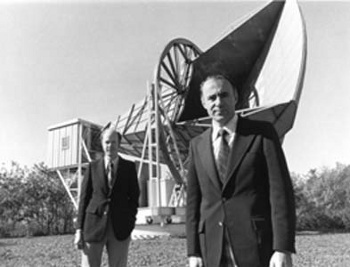Harvesting Radio Frequency Energy
November 22, 2011
The
light switch for my
cellar is the type with a
neon bulb built into the switch handle. When the cellar lights are off, the switch handle is illuminated. Well, that's how it worked for the first few decades. Then, either some of the neon leaked out of the bulb, or the
electrodes became contaminated, and the switch handle wasn't illuminated all the time. However, when it was off, touching the switch with a finger would cause the neon bulb to light.
The magic involved in lighting the neon bulb had a simple technical explanation.[1] My body was acting as an
antenna for
radio frequency signals, and my finger would
capacitively couple this extra
energy into the neon gas to allow it to produce a
plasma. There's a lot of radio frequency radiation everywhere, from
broadcasting stations to
cellphones. Much of it is harvested by the
power lines that enter our homes.
Transformers will block radio frequency signals on the power lines, but there are still long runs of
highly conductive wire from the nearest step-down transformer to your household wiring. That's one reason why there's too much
interference from various
harmonic generators to get good
AM radio reception in your home.
Now that many electronic devices require so little
power to operate, research in
environmental energy harvesting has become popular.
Radio frequency energy harvesting is a subset of this research area. The table below is a summary of environmental energy available from various sources.[2]
| Source | Power Density
μW/cm2 | Power Density
μW/cm2 |
| Vibration/Motion | 4
(Human) | 100
(Industrial) |
| Temperature Difference | 25
(Human) | 1,000-10,000
(Industrial) |
| Light | 10
(Indoors) | 10,000
(Outdoors) |
| Radio Frequency | 0.1
(GSM) | 1
(Wi-Fi) |
As can be seen from the table, ambient radio frequencies have lower energy than other environmental energy sources. However, if we accept the 1 μW/cm
2 factor, this means that a 10 cm x 10 cm antenna would harvest 100
microwatts. This is enough power for many
sensors that just need to wirelessly update their state a few times each hour.
Of course, ambient radio frequencies cover a wide
bandwidth. There's
AM radio at about a
megahertz,
cellphones at about a
gigahertz and beyond, and
Wi-Fi data networks at 2.4 and 5 GHz. Low frequency signals are usually ignored, since their long
wavelengths require very large antennas for efficient energy collection. A
Georgia Institute of Technology team, led by
Manos Tentzeris, a professor of
electrical and
computer engineering, has been conducting research on small,
wideband antennas for energy harvesters that collect energy from radio frequencies in a band from 100 MHz to potentially 60 GHz.[3]

A spiral antenna for radio frequency energy harvesting.
Spiral antennas are broadband antennas that are especially suited to this application.
(Illustration by the author)
The Georgia Tech research is facilitated by the process they use to fabricate the antennas. Tentzeris and his team have been printing their antennas since 2004 using
inkjet techniques. Some of their research is in the
conductive inks for this process, and they can print on a variety of substrate materials, although
polyimide offers the best high frequency performance. Their RF energy scavenging systems have produced hundreds of microwatts of power.[3]
Nokia, at its
Cambridge, UK, research laboratory, has also been investigating RF energy scavenging systems that operate at high frequencies, from 500 MHz to 10 GHz. Although details of the device and test environment have not been disclosed, Nokia claimed 3-5 milliwatt power in 2009, with a short-term goal of 20 milliwatt, and a stretch goal of 50 milliwatt. Their logic is that, since one
transmitter will give a few tens of microwatts, reception of a thousand transmitters will give tens of milliwatts.[4-5] I'm somewhat skeptical, but such power levels are possible with a large enough antenna.

Now, that's an antenna!
Robert Wilson (left) and Arno Penzias in front of the Bell Labs Crawford Hill, New Jersey, horn antenna they used in their discovery of the cosmic microwave background radiation.
(Via Wikimedia Commons))
In 2009,
Intel powered a small
weather station using RF energy scavenged from the
television transmitter of
KING-TV, located about two and a half
miles away. This transmitter broadcasts on frequencies between 674 and 680 MHz at almost a megawatt of effective radiated power. The combination of a nearby, high power transmitter, and a harvesting antenna with a 5 dB
gain, resulted in 60 microwatts of harvested power.[6]
Radio frequencies are an
alternating current power source, so
rectifier circuitry is needed to convert the power to
direct current. Since the typical antenna
source impedance is fifty
ohms, a milliwatt of power corresponds to about 0.2
volts.
Silicon rectifiers don't work well below 0.7 volts, and low voltage electronic circuitry operates at about 1.8 volts, so some step-up method is needed.
As a first step, the voltage can be increased by a suitable step-up
transformer. After that, the most useful rectification method is the use of a
switched capacitance filter, in which the
diodes of a
voltage multiplier circuit are replaced by
field effect transistors.[7] The Intel demonstration used a four stage
charge pump, which is a type of
voltage multiplier.
References:
- I refer you to Arthur C. Clarke's Third Law, "Any sufficiently advanced technology is indistinguishable from magic."
- Murugavel Raju, "ULP meets energy harvesting: A game-changing combination for design engineers," Texas Instruments, 2008.
- Amanda Davis, "Harvesting Energy out of Thin Air," The Institute (IEEE), October 21, 2011.
- Duncan Graham-Rowe, "Wireless Power Harvesting for Cell Phones, Technology Review, June 9, 2009.
- John Walko, "Nokia working on energy-harvesting handset," EE Times, June, 11, 2009.
- Jaymi Heimbuch, "Intel Demos RF Energy Harvesting Technology," TreeHugger.com, January 29, 2009.
- M. Muramatsu and H. Koizumi, "An experimental result using RF energy harvesting circuit with Dickson charge pump," 2010 IEEE International Conference on Sustainable Energy Technologies, (December 6-9, 2010), pp. 1-4.
Permanent Link to this article
Linked Keywords: Lighting; light; switch; cellar; neon bulb; electrode; antenna; radio frequency signal; capacitively couple; energy; plasma; broadcasting station; cellphone; power line; transformer; electrical conductor; conductive; wire; interference; harmonic; AM radio; power; environmental energy harvesting; radio frequency energy harvesting; Watt; W; sensor; microwatts; bandwidth; AM radio; megahertz; cellphone; gigahertz; Wi-Fi; wavelength; Georgia Institute of Technology; Manos Tentzeris; electrical engineering; computer engineering; wideband; spiral antenna; inkjet; conductive in; polyimide; Nokia; Cambridge, UK; transmitter; Robert Wilson; Arno Penzias; cosmic microwave background radiation; Wikimedia Commons; Intel; weather station; television transmitter; KING-TV; mile; antenna gain; gain; alternating current; rectifier circuitry; direct current; characteristic impedance; source impedance; ohm; volt; silicon rectifier; transformer; switched capacitance filter; diode; voltage multiplier circuit; field effect transistor; charge pump; oltage multiplier; Arthur C. Clarke's Third Law.